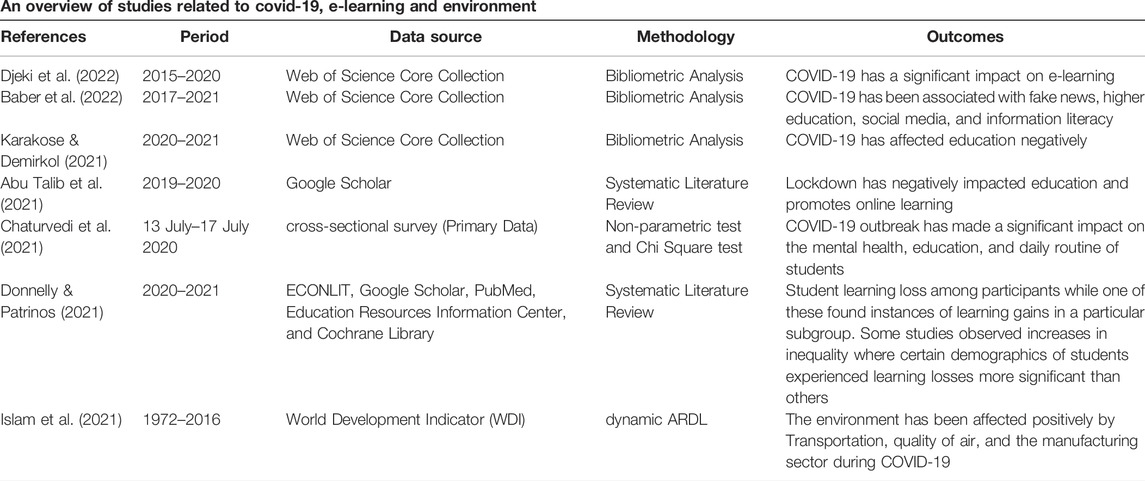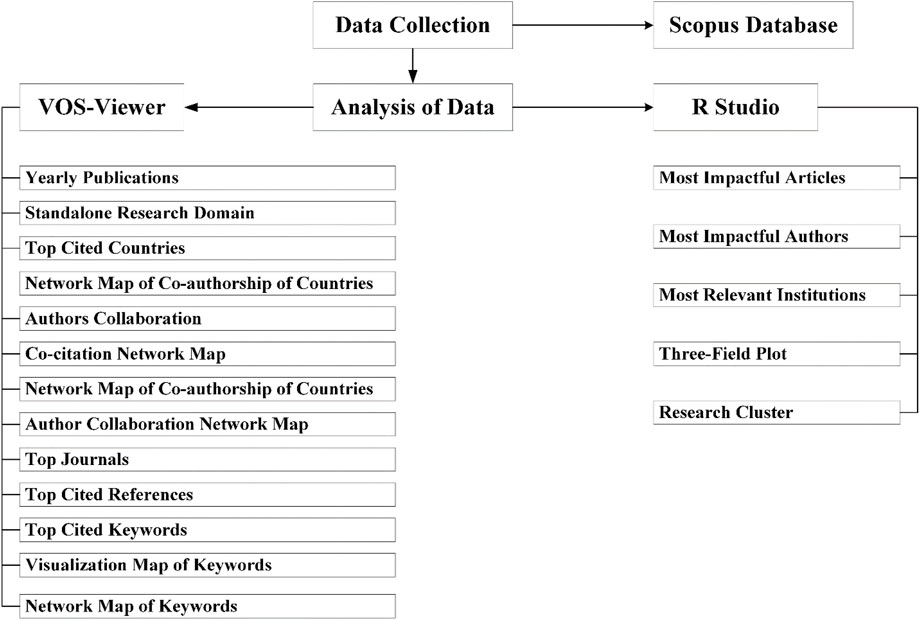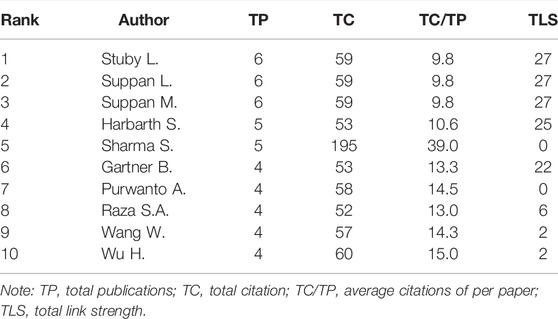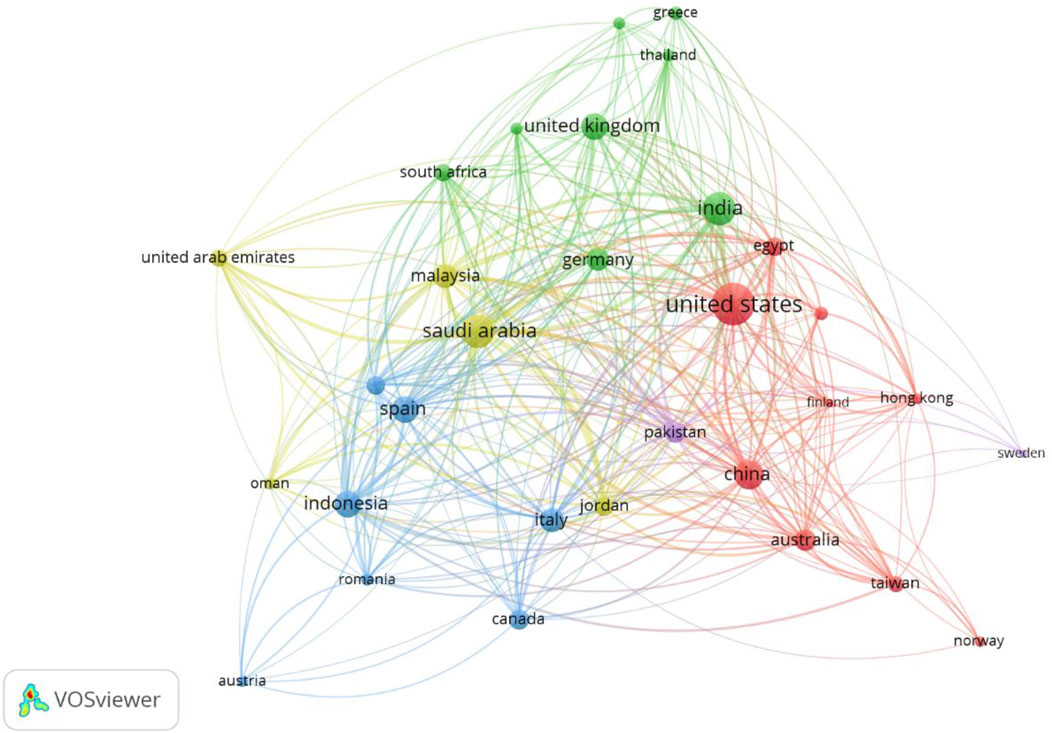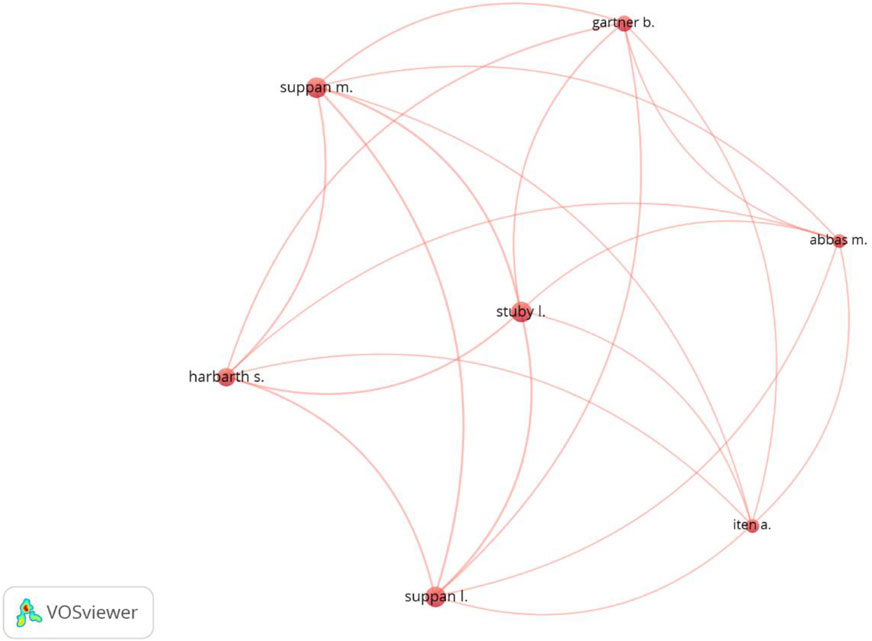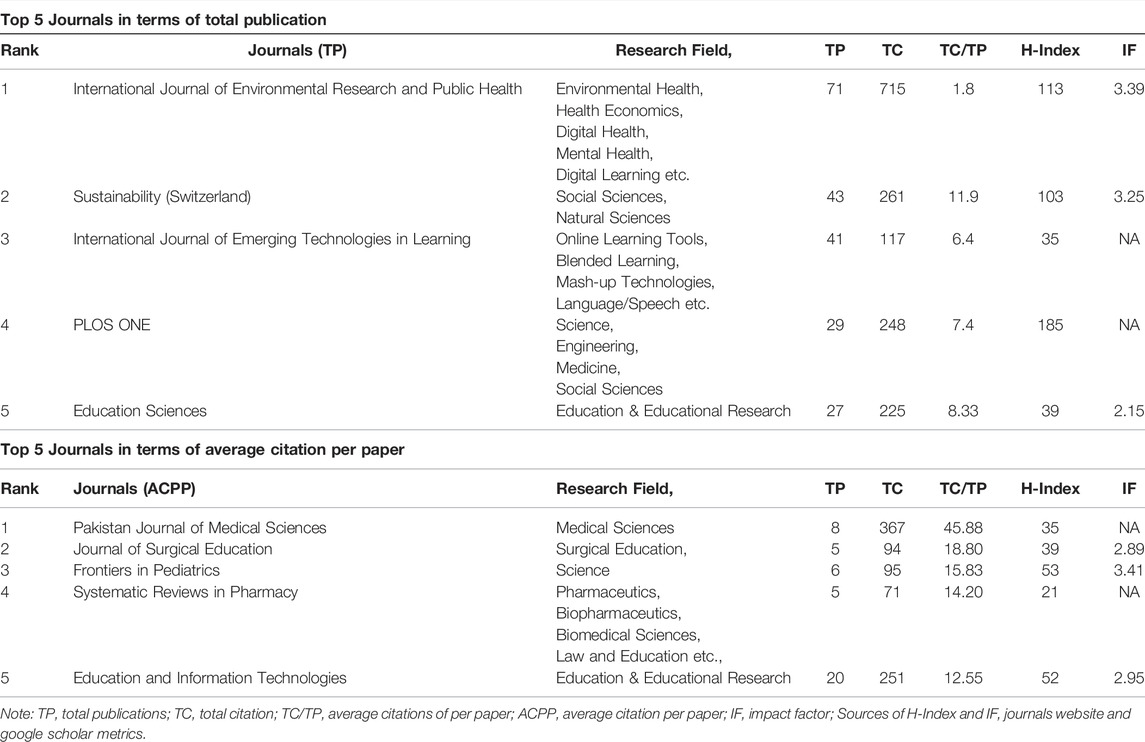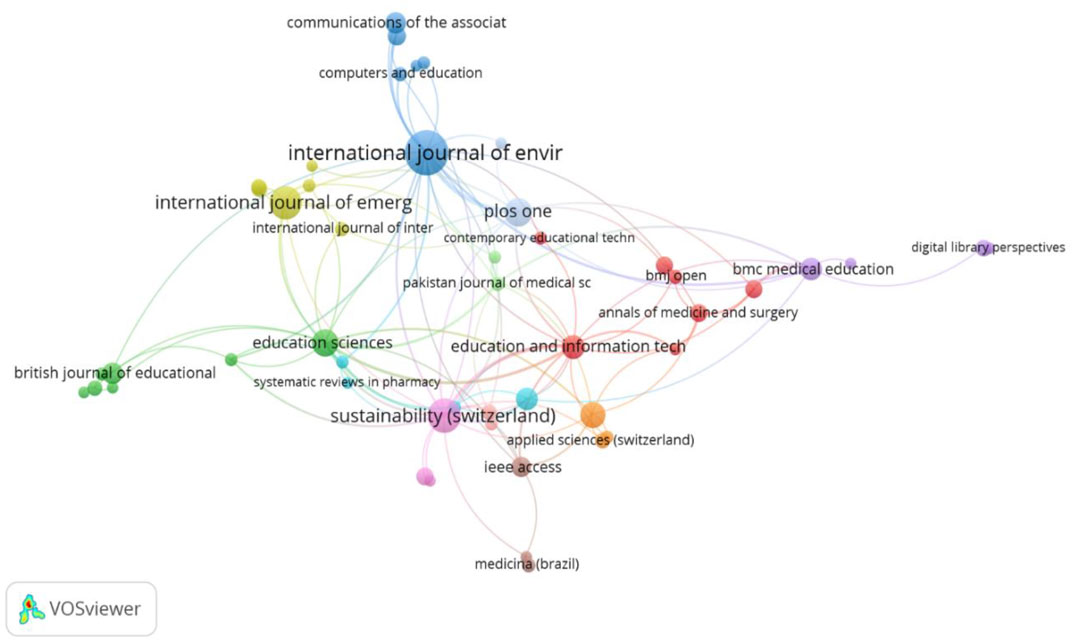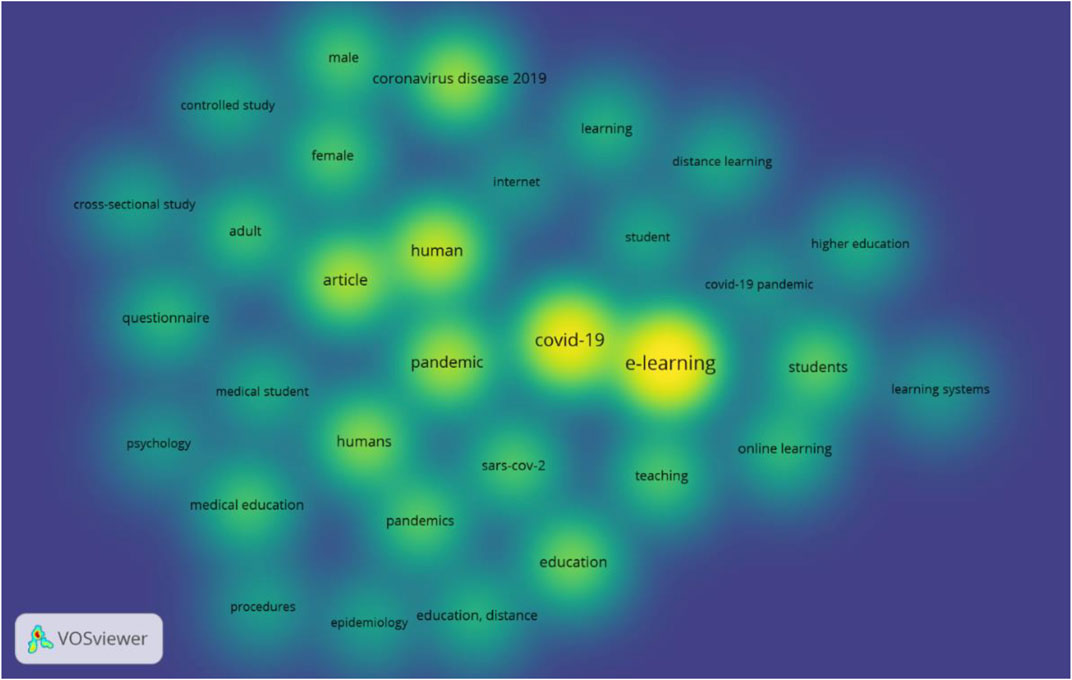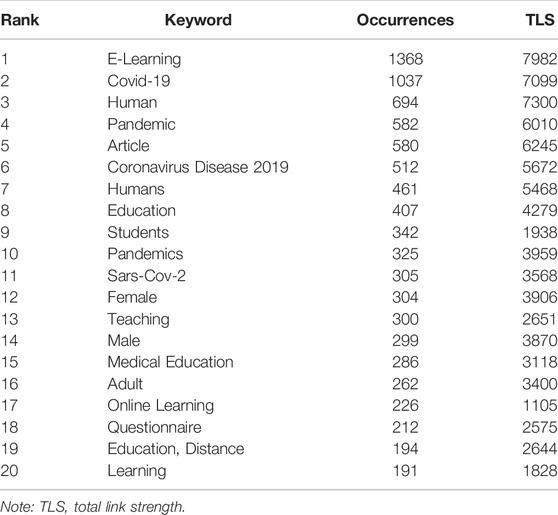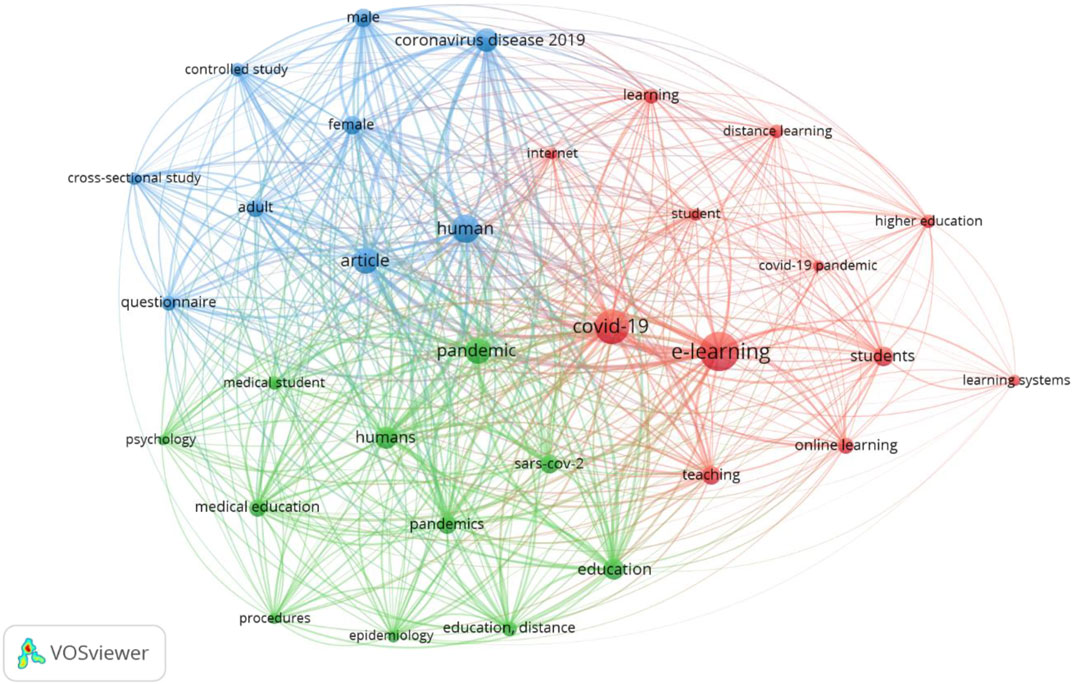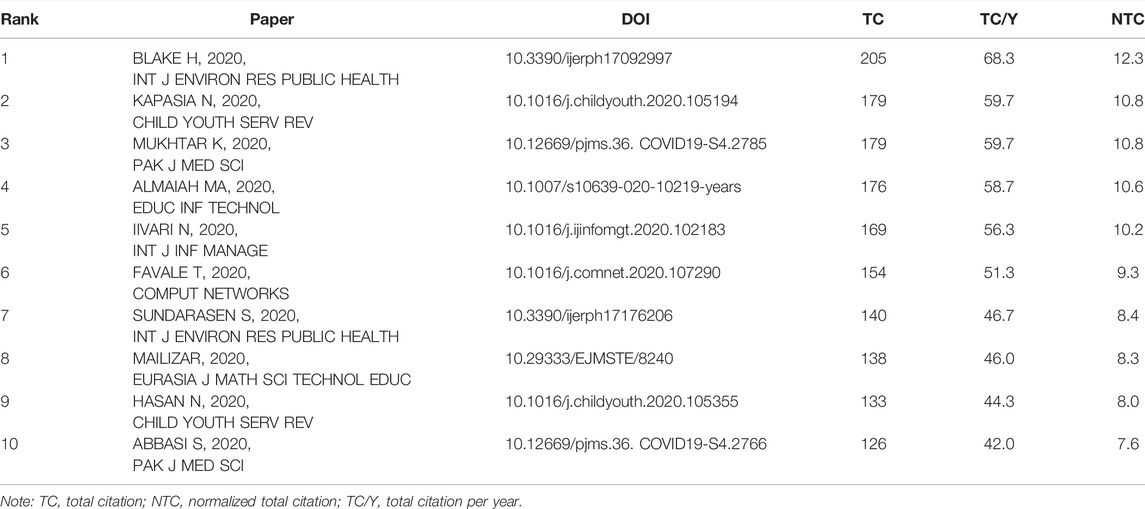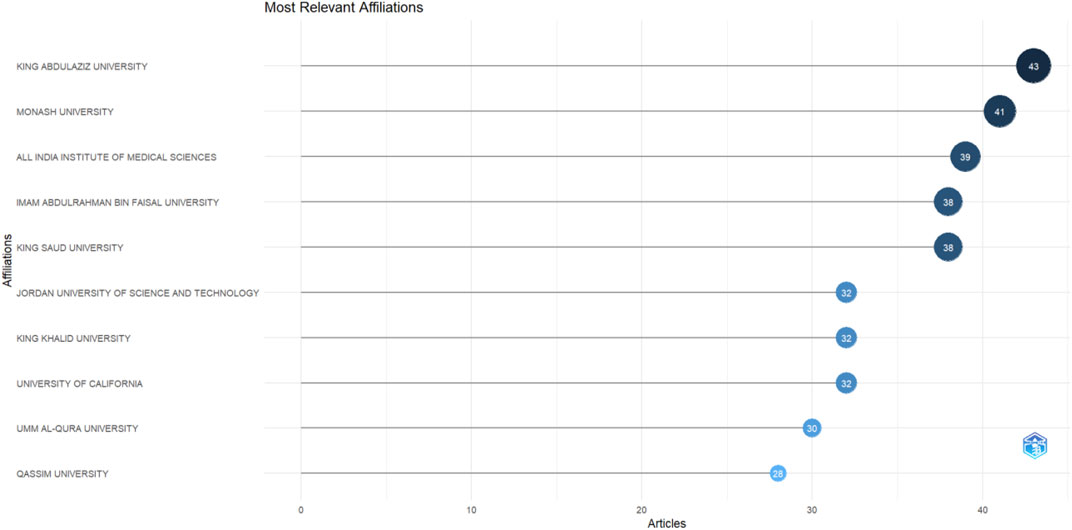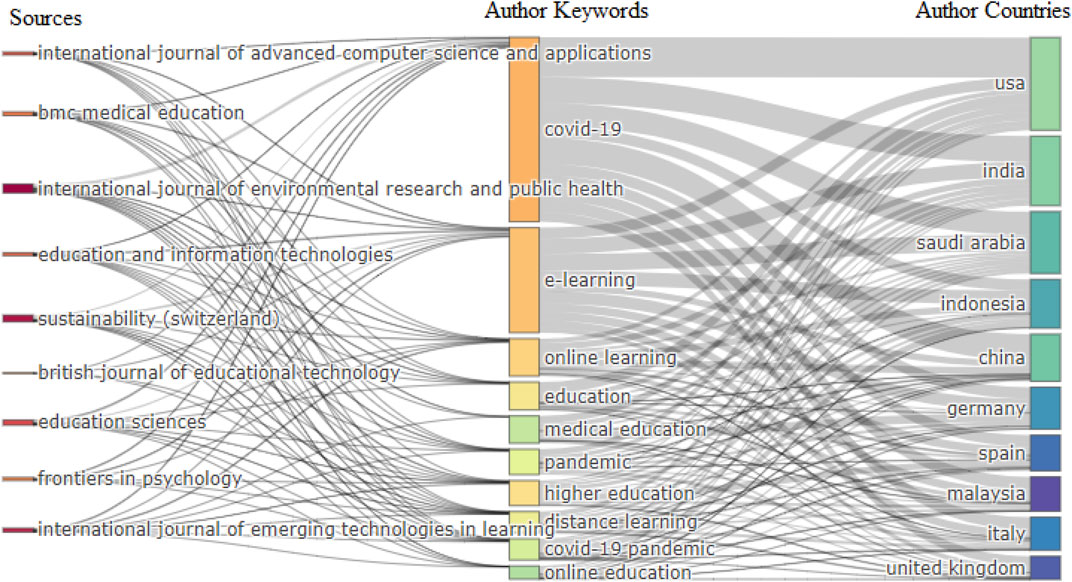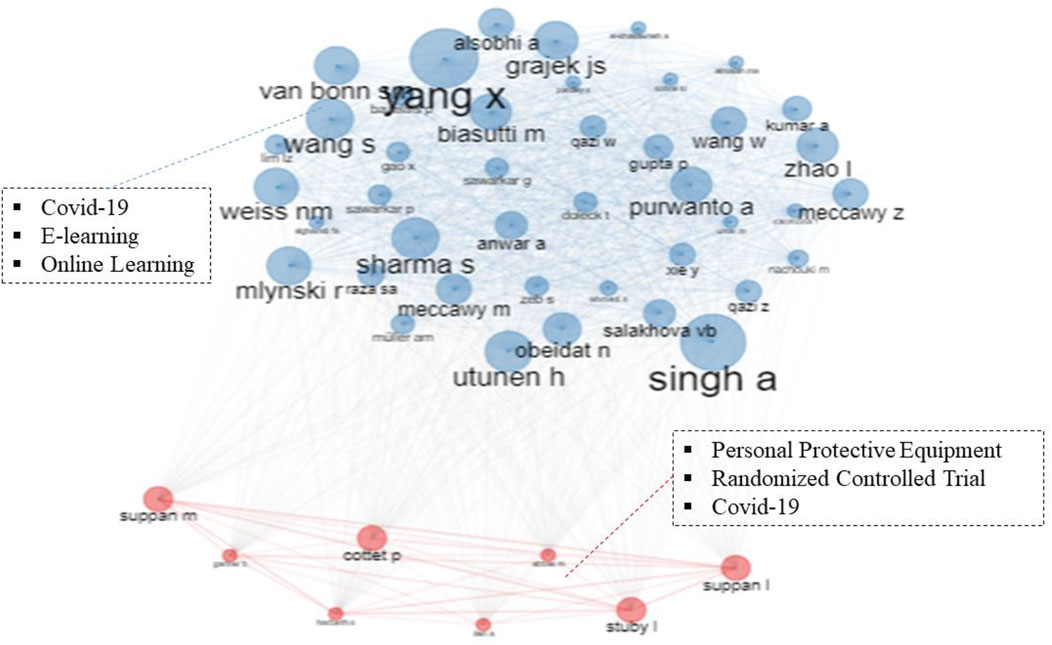- 1Department of Finance, College of Administrative and Financial Sciences, Saudi Electronic University, Jeddah, Saudi Arabia
- 2Department of Commerce, Aligarh Muslim University, Aligarh, India
- 3Department of Economics and Finance, College of Business Administration, University of Bahrain, Sakhir, Bahrain
- 4Department of Finance, College of Business Administration, Prince Sultan University, Riyadh, Saudi Arabia
- 5Department of Management, College of Commerce and Business Administration, Dhofar University, Salalah, Oman
The COVID-19 pandemic has pushed the world towards a digital era and affected the environment significantly. The present study uses a bibliometric approach to provide a comprehensive overview based on existing literature related to COVID-19 and E-learning and its environmental consequences, particularly from the year 2020–2022. In addition to the terrible impact of the pandemic on the world, environmental advantages have also been noticed. The findings show that the use of E-learning reduces the consumption of paper and prevents the cutting of trees which makes the environment more sustainable. The optimum use of technology leads to the conservation of the environment. Second, E-learning ensures developing and less developing countries to provide education at lower levels or remote areas of the society. The findings also suggest that governments and educational institutions should upgrade technology and digital tools in order to enhance E-learning education. Additionally, reviewing 1807 published articles extracted from the SCOPUS database, enrich literature related to COVID-19, E-learning, and the environment. This study also represents a graphical visualization of the bibliometric analysis using VOSviewer and R studio software. A coupling map and three-field plot also have been used for directions for future research.
Introduction
The COVID-19 pandemic does not only manifest multiple complexities for human lives but also severely affects the socio-economic conditions of the people. Each and every sector has been badly hit by this deadly disease, directly or indirectly, throughout the world (Razzaq et al., 2020; Wang & Tian, 2021). In addition to the negative aspects of the pandemic, some positive outcomes have also been seen in relation to the environment. Due to the lockdowns and other travel restrictions, environmental improvement was also noticed. Improved air and water quality, reduced noise pollution, and minimized energy consumption are some of the key well-beings for the environment. Additionally, a revolution has occurred in the education sector in the form of Online/E-learning. It enables teaching-learning activities more convenient. Hence, affordability, flexibility, and accessibility are considered determinants of E-learning. The main aim of this study is to extensively explore the diverse consequences of the pandemic. It also provides an insight into the environmental knowledge that helps to formulate policies for a sustainable environment. The present study indicates that E-learning is an effective tool to reduce the excessive use of paper which prevents the cutting of tree and helps to maintain the environmental sustainability.
Particularly, the education sector has been highly affected by this pandemic across the globe. The effect of this pandemic is unprecedented and wide which has disturbed the entire community of teachers and students. As a result of this tragedy, many schools, colleges, and universities were temporarily shut down, globally (Daniel, 2020; Rashid & Yadav, 2020). However, several tactics, for instance, lockdown, social distancing, and stay-at-home were implemented by the administration of the different countries to deal with and control the spread of this transmitted disease (Sintema, 2020; Pokhrel & Chhetri, 2021; Singh et al., 2021). At the same time, educational institutions were scrambling to come up with solutions to these fierce circumstances. During such situations, Online or E-Learning proved as a panacea and facilitated teaching-learning activities (Dhawan, 2020). Online classes provide innovative teaching-learning methods, advanced tools, and techniques as well as the ability to reach a large number of students (Appana, 2008). On the other hand, students and teachers become familiar with emerging technologies, for example, how to use various tools and methodologies, pay concern to recorded or live talks with world-known professionals, interact and learn lessons often, and work with creativity pace (Arkorful & Abaidoo, 2015).
Furthermore, the pandemic has completely transformed the traditional pattern of education into digital. Before such changes, people were not much conscious of academic E-resources. It could be said that E-learning made teaching-learning more accessible, flexible and affordable (Dhawan, 2020). Teachers and students can now easily collaborate anytime and anywhere for learning activities, there is no need for physical classrooms. Especially in India, most of the students belong to rural or remote areas and it was difficult for them to get an education due to the lack of resources, online learning provides a chance to obtain substantial education (Alvi & Gupta, 2020). Apart from the several advantages of online learning, challenges and difficulties also exist. It was a great challenge for the entire educational community to transform themselves to deal with such a digital era. Therefore, the government is more concerned about education during and after COVID-19 and has taken several initiatives for dealing with the smooth teaching-learning process across the world (Singh et al., 2021). Consequently, multiple digital-educational platforms, EdTech startups, and online learning portals came into the limelight to continue the educational system’s rhythm. E-learning resources made education much more convenient and facile. One can easily access academic and professional literature from anywhere within a few moments using strong internet connectivity. However, a variety of issues and topics associated with E-learning have been explored in recent years in multiple disciplines including science, social sciences, engineering and technology, and management (Djeki et al., 2022). To be familiar with emerging and trending researches, most-contributed universities and countries, and influential articles and authors in the field of education become approachable using E-learning. For a deep and extensive understanding of this wide and diversified topic, a thematic review of related works is required. Several research articles exist related to“COVID-19 and E-Learning”, but a few of them have been done with bibliometric analysis. The “COVID-19” and “E-Learning” keywords have been frequently used to search out research papers containing bibliometric analysis. A bibliometric analysis is an analysis tool to investigate the existing literature using some specific keywords and set criteria. The main objective of the present study is to examine the research trends and topics concerned with COVID-19 and E-Learning and to analyze how the educational pattern has transformed within the foregoing 3 years (i.e., 2020–2022). The bibliometric analysis method has been employed on the SCOPUS database from the year 2020–2022 to exhibit the research themes and effective entities.
Apart from the tremendous influence of COVID-19 on human lives, economy and culture, it has also proved a panacea for the environment from different perspectives (Alvarado et al., 2021; Dagar et al., 2021). In addition, online learning is an excellent source to reduce paperwork that results in saving trees, minimizing pollution and emission from traffic, less energy consumption, and water and other natural resources being conserved (Jan et al., 2021; Islam et al., 2021; Khan et al., 2022). These are the unavoidable and indirect benefits of online learning that help to create a sustainable environment (Zhang et al., 2022). Environment conservation is the major concern of the world under which several initiatives are being taken across different countries (Rehman et al., 2021; Zakari et al., 2021). The pandemic has coerced the educational system to change from traditional patterns to online learning. During the pandemic, obtaining proper education was a great challenge across the world due to the lockdowns and shutdown of schools. In this regard, E-learning proved as a catalyst to maintain the rhythm of systematic educational activities. E-learning plays a crucial role in the education sector making people aware of how to utilize the emerging resources for getting an education without exploitation of the pandemic restrictions. Hence, E-learning has been considered as an eco-friendly instrument to use in which multiple resources could be sustained for the long term (Irfan et al., 2021). Prior studies have not had many environmental concerns while this study mainly focuses on environmental sustainability through the implementation of E-learning resources. With the aim to emphasize on the socio-economic outcomes of the pandemic, the present study is distinct from previous ones. The incorporation of the bibliometric approach reveals the research novelty in examining the wide range of consequences of COVID-19. This study enhances the awareness among consumers about environmental conservation through the optimum use of digital resources and reports the wide range of socio-economic consequences globally.
Therefore, based on the aforementioned discussion, this study proposes the following objectives. First, the present study tries to investigate the socio-economic consequences of COVID-19 from different perspectives using bibliometric analysis. Second, this study reports the influences of COVID-19 regarding the environmental concerns. Third, it also extensively marks the impacts of COVID-19 from the educational as well as socio-economic perspectives. Fourth, it also identifies the most-relevant journals, articles, institutions, and authors in this field of study, as well as the collaboration network of authors and universities. It also examines the COVID-19 and E-Learning research trends and publication productivity from 2020 to 2022. Authors and countries have made a significant contribution with respect to COVID-19 and E-Learning research; therefore, this study investigates the most-cited publications on the subject of COVID-19, E-Learning, and education research and reports on the emerging research topics and trends in the field of education.
Review of Literature
In addition to the gruesome effects of the COVID-19 pandemic on human lives, it has proved a catalyst for the environmental aspect. In addition, travel restrictions lead to the minimization of air pollution, water pollution, and exploitation of natural resources (Alvarado et al., 2022; Razzaq et al., 2022). Conservation of the environment and natural resources has been a major concern of the world ever. But during/after the COVID-19 pandemic, several positive changes have been seen with respect to the environment and its sustainability (Razzaq et al., 2021). Lockdowns, social distancing, and other restrictions imposed by the government to facilitate the environmental rectification such as improved quality of air and water, CO2 emissions reduced by transportation, Information and communication technologies, and technological innovation, and also decreased the energy consumption (Chien et al., 2021; Islam et al., 2021; Razzaq et al., 2021). During the pandemic, apart from the environmental advantages, integration of the different means of information and communication technology has taken place to deal with the pandemic hindrances and maintain the magnifier of the education sector (Irfan et al., 2022). Online learning, one of the most significant instruments of information technology, has emerged in the education sector that has made teaching-learning activities more convenient by providing E-learning assistance without violation of the pandemic norms (Chauhan et al., 2021). Certainly, E-learning is also an exquisite means of conservation of the environment by reducing the use of paper which is the main cause of cutting down the trees. Moreover, E-learning contributed a lot to the education sector during the pandemic while it was not much prevalent earlier but now has become a convenient instrument for getting an education.
Several meta-analyses and bibliometric analyses have occurred related to the education sector and COVID-19. For instance, Djeki et al. (2022) conducted a bibliometric study using 12,272 articles related to E-learning from the year 2015–2020 using the Web of Science database in which they examined the collaborations between authors, universities, and countries, and trending research topics and issues. Resulted collaborations are very low and the pandemic has a significant influence on education during the period. Baber et al. (2022) have reviewed 2307 research articles extracted from the Web of Science database related to the digital literacy pre and during the COVID-19 pandemic. Cluster analysis has been done to identify the rotative keywords and their thematic progression and trends over 5 years. In conclusion, a consistent pace of publications comes from the domains of education and library, and the United States moving ahead in this area. Moreover, some trends are emerging such as competence, health literacy, fake news, COVID-19, and education. Chaturvedi et al. (2021) have explored the impact of COVID-19 on the education, mental health, and social life of students belonging to different age bars through a set criterion. The results have shown that the administration should pay deep concern and adopt essential steps for improving the learning experience and cope with the negative impact of the pandemic. A systematic review has been conducted by Donnelly and Patrinos (2021) that reported the learning loss due to COVID-19 for 1 year. On the basis of eight studies, the author reported that one of them claimed learning gains in a specific subgroup and the rest have witnessed heavy learning loss. Some of the studies reveal inequality among demographics of students resulted in a learning loss. According to Abu Talib et al. (2021), technological advancements rapidly took place in the field of higher education during the period of a pandemic. To deal with unprecedented changes in the education field, the educational system has now become more dependent on technology. In the light of emerging trends in technology-based education, it would not be wrong to say that gaining education without using technology would be impossible in the near future. A bibliometric analysis was performed by Karakose and Demirkol (2021) to examine the emerging trends and current status associated with COVID-19 and the education, in which data has been extracted from the “Web of Science Core Collection” and analyzed using VOSviewer and “GraphPad” software. They found that most of the articles were published with a “theoretical model” using “scale/interview forms”. Another interesting finding is that articles sent for publication at that time were responded to very quickly and got published before the usual time period of respective journals. Adedoyin and Soykan (2020) reported the opportunities and challenges regarding COVID-19 and online learning in a previous study; E-Learning would be more effective and sustainable if the teaching-learning would become hybrid. Accordingly, the distinctiveness of the current study is to explore the literature of highly sensitive years (2020, 2021, and 2022) of the COVID-19 pandemic which has enormous unprecedented transformations in different facets of normal life and simultaneously educational perspectives. Most of the studies have been conducted using the Web of Science database but this study is being conducted with the Scopus which is the largest combination of abstract and citation database of reputed peer-review literature. It widely covers approximately 36,377 titles, around 11,678 publishers, and around 34,346 peer-reviewed journals on multidisciplinary subjects. No previous studies have revealed the influence of information technology means, that is, online/E-learning on environmental and socio-economic perspectives through the existing literature during/post-pandemic. The present study bridges this gap by bringing a more lucid and vivid study on e-learning and the environment.
An overview of studies related to COVID-19, e-learning, and environment.
Data Collection and Research Methodology
Data Collection
The Scopus database was used to collect extensive professional and scientific literature to cover global research on E-learning and COVID-19. The data was extracted on 18 March 2022. The key terms have been used in the search: topic = (“E-Learning” and “COVID-19”), in title-abs-key (“e-learning” and “COVID-19″) and [limit-to (doctype,“ar”)] and [limit-to (srctype,“j”)] from 2020 to 2022, and 4207 studies were found over the years (Conference paper 1882, Articles 1807, Review 169, Letter 140, Editorial 62, Conference Review 47, Book Chapter 36, Data Paper 6, and Short Survey 5) but the researchers have selected only research articles in this study.
The data of the bibliometric study represent the entire research on “COVID-19 and E-learning” in the Scopus database. The usage of e-learning was anticipated to rise in the last 3 years (2020, 2021, and 2022) owing to the lockdown and quarantine processes.
There are various reasons why this database was chosen above others, notably web of science (WoS) and Science Direct: the area of scientometrics has improved greatly as a result of the Scopus database. Scopus is much more than a simple database of academic publications.
Research Methodology
Bibliometrics is a subfield of library science which analyzes bibliographic data statistically (Mas-Tur et al., 2020). Bibliometrics analysis is a method of gaining a comprehensive picture of huge breakthroughs in either a research journal, specific area, or a country (Hood and Wilson, 2001). Moreover, it facilitates the identification of prominent authors working in the area in order to enable future collaborations. The data were evaluated using a graphical analysis using VOS-viewer to better comprehend the results (Van Eck & Waltman, 2010). Statistical analysis and graphical representation are useful because they can assist researchers in a deeper understanding of what has been studied so far in the field of e-learning and COVID-19 related topics. Moreover, it assists in identifying and mapping the megatrends throughout this discipline. VOS-viewer is a software that gathers bibliographic data from several databases such as Scopus, PubMed, Science Direct, and Web of Science, etc. It provides graphical maps that depict and present the results of several procedures, such as co-citation analytics, bibliographic coupling, co-authorship, and keyword co-occurrence (Guo et al., 2021). When two articles are cited by the same third article, this is known as co-citation. The tremendously valuable results of bibliographic coupling have been evaluated by determining those common articles that cite the articles in observation more frequently. Co-authorship refers to the number of publications produced by a group of variables, such as countries, authors, and institutions, as well as their relationships. The most frequent and common keywords used by the articles in the study are referred to as co-occurrence of keywords.
Lotka’s Law is considered a bibliometric measurement of authorship concentration that quantifies the frequency with which authors publish research articles. The key premise is that in any particular topic, a limited number of authors are extremely productive, while a large number of authors contribute only a single article. According to Lotka’s law, the numerous authors who publish x number of articles is about 1/xb of those who only publish one article. As a result, a larger b value implies greater authorship concentration, while a low value implies the absence of a devoted group of authors in a certain research field. Lotka’s Law does have the following general formula:
C is a research area-specific constant, while f(y) is the number of occurrences of studies produced by each author of a population.
Using a Walktrap clustering technique provided by Pons and Latapy (2005), we show university and author collaboration. This network analysis approach has a notable advantage in terms of the quality of the calculated partition and the running duration for large networks (Pons & Latapy, 2005). Additionally, we employ a Three-Fields plot based on a Sankey diagram to depict the relationships between journals, keywords, and countries. Kessler's (1958) bibliographic coupling approach is utilized to identify the cluster of the underlying research and map present research advances. Two or more publications are said to be bibliographically coupled if they carry at least one common citation (Kessler, 1963). As a result, studies that are bibliographically coupled are likely to share the same underlying research theme. The following standard formula can be used to express a bibliographic coupling network of studies published (Aria & Cuccurullo, 2017).
Bcoup consists of the matrix bij, which reflects the number of common references between articles, and A is a document × cited reference matrix. We have used the open-source R programming application Bibliometric package (Biblioshiny) to analyze bibliographic coupling (Aria & Cuccurullo, 2017). Figure 1.
Results and Discussion
Yearly Publication Trends
The yearly publishing trend is useful for determining the topic’s progress, literature accumulation, and maturity. Table 1 shows that there were 1807 articles published between 2020 and 2022. The highest research articles were published in 2021 (65.5%). It was more than 50% over the years like 2020 (18.8%) and 2022 (15.6%). The trend of publication is an inverted V shape because in 2021 more than 50% published articles. And the year 2022 has also seen a good number of publications until the 18 March of 2022.
Standalone Research Domain
Research productivity in the context of e-learning and COVID-19 in education demonstrates that there are 6977 authors in this field who have published only one publication. One author, on the other hand, has contributed to a maximum of seven published research articles. According to Pao (1986), the value of b in Lotka’s law normally ranges from 1.78 to 3.78 for most fields. In this investigation, the calculated b value of 1.904 fits within the range seen by (Pao, 1986). As a result, e-learning and COVID-19 in education constitute a separate research topic, although one with a high degree of authorship concentration.
Analysis of the Top 10 Most Cited Countries
The geographic distribution of articles may be discovered by looking at the number of countries that were published in this field. According to Table 2, the United States has published the most prominent productive research articles on the field of e-learning and COVID-19 from 2020 to 2022, and United States has published 245 articles (13.5%), preceded by India, which published 151 articles (8.3%). The top 10 countries published 1166 out of 1807 articles, which contributed to 64.52% of the total on the topic of e-learning and COVID-19 and the rest of the country’s 35.48%. Figure 2 shows that the United States and India have published the most publications on this topic. The most cited countries are the United States and Saudi Arabia (1336 and 1084, respectively), but India is not the most cited country as seen in the network map and Table 3. Saudi Arabia and Malaysia are the most collaborated countries, with 264 and 155 total link strength (TLS). United States, United Kingdom, China, India, Pakistan, Spain, Italy, and Indonesia are the countries having the most collaborations with Saudi Arabia and Malaysia. Furthermore, these two countries have collaborated with each other. The United Kingdom is the third country in terms of citations, with 817 citations, and has collaborated with the United States and Saudi Arabia. Since 2020, the United States and India have been actively publishing research articles on this field, but some countries have joined lately, such as Ukraine, Nepal, Vietnam, Croatia, Ghana, Philippines, Chile, Colombia, Finland, Morocco, Palestine, and Sweden. It's important to note here that countries that fail to collaborate with other countries are eliminated from the network map by default. The lines linking the map’s nodes denote co-authorship between countries, and the length between them denotes their strength and the number of publications among co-authoring countries. This presents a comprehensive assessment of the different countries’ collaboration strengths in the area of e-learning and COVID-19.
Analysis of Author Collaboration and Author Co-Citation Network Map
The examination of author collaboration indicates the topic’s research potential and provides insight into the topic’s advancement (Guo et al., 2021). While analyzing the 1807 publications, the authors discovered that 7128 different authors made significant contributions in this field. The smallest number of publications and citations contributed by an author was set at 3 and 50, respectively. Nineteen authors met the criteria shown in Figure 3 and collaborated with others. Table 3 shows the top ten most productive contributors from 2020 to 2022. Stuby L. (6 articles, 6 links, and 27 link strength) lead the list of publications in this field. Suppan L. (6), Suppan M. (6), Harbarth S. 5), and Gartner B. 4) articles are among the other authors with a significant publication record.
Analysis of Top Journals
It is crucial to investigate the number of publications and the frequency of citations in order to identify journals in this field. Table 4 shows the top 5 most productive journals in terms of total publication and average citation per article. International Journal of Environmental Research and Public Health has 71 articles on this subject from 2020 to 2022. This journal publishes mainly on Environmental Health, Health Economics, Digital Health, Mental Health, and Digital Learning themes and has an H-index of 113 and an impact factor of 3.39. It means that researchers frequently link digital learning to mental health and Digital health during COVID-19. It's interesting to note that the Pakistan Journal of Medical Sciences with an average citation per article (45.88) belongs to medical science and public health, indicating the importance of health during COVID-19 for humanity. Frontiers in Pediatrics has a high H-index (53) and impact factor (3.41), which is followed by the Journal of Surgical Education (H-index 39 and impact factor 2.89), indicating the importance and relevance of this field. Figure 4 also shows the top productive journals of COVID-19 and E-learning.
Analysis of Top Cited References
The top 5 highly cited references from 2020 to 2022 were examined, as shown in Table 5. The highly cited article was published by the Journal of Educational Technology Systems, and it has been cited 25 times during this period. Journal of Educational Technology Systems has published articles on Information Literacy and online learning for a long time. It has gained a lot of popularity among the scholars of online learning; that is why this article is listed in the highly cited reference during this period. The third most citations were obtained in the publication Human Behavior and Emerging Technologies’ article “COVID-19 and Online Teaching in Higher Education: A Case Study of Peking University”. The objective of this research was to conduct a case study of online education at Peking University. Six alternative instructional approaches are presented to describe current online teaching experiences for university professors who may perform online education in similar conditions.
Attractive Research Field
The frequency of occurrences of a keyword indicates the domain space and vital content of a certain topic/subject. Figure 5 depicts the keyword co-occurrence networks and highlights digital literacy research encompasses a varied and mixed set of areas. This map was generated using the criteria-type of analysis described as follows: co-occurrence, all keyword and counting method, and full counting. The threshold number of occurrences for a keyword in the article was set at 100 to ensure that we focus exclusively on the most prominent keywords. 32 keywords were extracted from 8263 total keywords, and the frequency and strength of the link of the top 20 keywords are demonstrated in Table 6. With a frequency of 1368, E-Learning is the most studied topic in this area, followed by COVID-19 (1037), Human (694), and Pandemic (582), as illustrated in Figure 6 using density visualization. It's important to note that the most commonly occurring keyword is E-Learning and COVID-19. Although COVID-19 has recently received significant attention by people due to the pandemic issues in many areas (e.g., education, economics, and social issues), the field of pandemics considers COVID-19 as a focal keyword. Additionally, the distance between e-learning and COVID-19 is relatively near among the top five keywords, showing the keywords’ strong relationship. The map classified the keywords into six distinct clusters.
Most Impactful Articles
Bibliometric techniques for TC identify seminal or recent breakthrough studies. Table 7 shows the most cited articles in terms of TC. We can identify significant publications that got the most citations within and beyond the sample of 1807 studies. According to estimates, Blake et al. (2020) is the most influential article on the e-learning and COVID-19 in the education sector, with the TC 205 and TC per year 68.3. Other influential studies with TC of one include (Kapasia et al., 2020), (Mukhtar et al., 2020), and (Almaiah et al., 2020).
Most Relevant Institutions
Figure 7 represents the most-relevant academic institutions that published e-learning and COVID-19 research in this field. The first position is King Abdulaziz University from Saudi Arabia, which contributes to 43 articles, the second is Monash University from Australia, which contributes for 41 articles, and the third position is All India Institute of Medical Sciences from India, which contributes 39 articles.
The other top relevant institutions comprise universities from Saudi Arabia (IMAM Abdulrahman Bin Faisal University, King Saud University, King Khalid University, Umm Al-Qura University, and Qassim University), Jordan (Jordan University of Science and Technology), United State (the University of California and Harvard Medical School), Indonesia (Universitas Indonesia) and Malaysia (University of Malaya). Under the top 10 universities are seven universities from Saudi Arabia.
Three Fields Plot
Relationships among journals, research areas, and countries can share important information. As a result, in Figure 8, the authors provide a new Three-Fields Plot that depicts the relationships between the most-relevant publications sources (left), author keywords (middle), and countries (right) in e-learning and COVID-19 in education research. The authors observed that most research on online learning and e-learning is published in the International Journal of Advanced Computer Science and Application, with the majority of them authored by the United States and India. Generally, the United States focused on COVID-19 research, India, Saudi Arabia, and Indonesia focused on e-learning research, and all other fields were covered by almost all these countries.
Research Clusters and Future Research Directions
There are various underlying research themes in every research field. Using bibliographic coupling analysis in e-learning and COVID-19 in education research, the authors identified two underlying clusters: 1) COVID-19, E-learning and Online Learning, and 2) Personal Protective Equipment, Randomized Controlled Trial and COVID-19 (see Figure 9). Both clusters are interconnected and built on each other. Inside every cluster, the authors critically assessed the contents of bibliographically related articles that provide similar underlying study topics and extracted significant directions for future research. To conduct the content analysis, the authors utilized an excel sheet with columns for the title of articles, publication’s year, author(s), journals, frequent keywords, methodology, key finding(s), and abstract (Salipante et al., 1982).
Hot Research Topics in Different Years (2020, 2021, and 2022)
Table 8 shows the top 10 keyword occurrences in 2020, 2021, and 2022. The minimum number of occurrences was set to 10 for a keyword in the article for 2020, 2021, and 2022 so that the authors focus on the prominent keywords only. The authors would extract 97 out of 2407 keywords, 248 out of 6146 keywords and 44 out of 1951 keywords, respectively, and occurrences of the top 10 keywords are shown in Table 8. E-learning is the hottest topic in this field, with the highest occurrences (258, 927, and 111) in 2020, 2021, and 2022, respectively. The e-learning keywords are most famous, with 927 occurrences in 2021 because the pandemic was at its peak, and researchers were most devoted to studying this field.
Conclusion and Recommendations
This study states how the Scopus database was used to explore online learning trends in education during the pandemic using a bibliometric approach. In terms of methodology, the suggested technique may visualize the temporal relationships of the most cited articles within separate streams and offers a comprehensive picture of the evolution of subjects in the Scopus database. Furthermore, citation network analysis enables researchers to study e-learning-related publications and offer a comprehensive summary of the issues raised in the papers.
In perspective of mapping research publications, this piece of research provides an insight into E-learning world. A scientific study was done with 1807 e-learning and COVID-19 documents from 2020 to 2022 that were found through the Scopus database. For most of the researchers and leading institutions, this study identifies emerging trends and contributes significantly in this field as well as prominent sources over period. This study aligns with a number of earlier studies in this field, including Hung (2012), Chiang et al. (2010), Cheng et al. (2014), Fatima and Abu (2019), Tibaná-Herrera et al. (2018), Mashroofa et al. (2020) and Bai et al. (2020). Nevertheless, this research depends on a variety of software to analyze diverse models and networks of E-learning and COVID-19. According to the analysis data, growth trends in research publications in various forms of e-learning and COVID-19 have drastically increased in recent years, particularly in 2 years (1184 in 2021 and 283 in 2022). 2021 was a peak time of COVID-19, so researchers found alternatives of traditional method to e-learning during COVID-19. The following are the significant findings of the bibliometric analysis: the prominent authors in this field are as follows: Stuby L., Suppan L., Suppan M., Harbarth S., Sharma S., Gartner B. and Purwanto A.; The King Abdulaziz University from Saudi Arabia is the most-frequently cited institution in this field of study; with respect to citations and publications, the United States leads the world; and during COVID-19, education drastically transformed into the e-learning mode and has developed into a recent research trend for many researchers.
This research investigated at a highly access topic, that is one of the hot topics right now “e-learning and COVID-19 in education” employed a bibliometric analysis of 1807 articles published in the Scopus database from the years 2020–2022. The authors determined that the sample of the study should be larger; additional studies and a longer time frame are required, particularly when analyzing citations, and research on this topic would be more explored in the future domain.
All the above findings of the study state that the developed countries quickly focused on e-learning method during COVID-19 but developing and less developing countries could not easily shift from traditional to e-learning processes. The reason behind it, that developed countries have been compatible with e-learning process because technology and digital tools were available easily but developing countries and less developed countries did not have proper resources for implementing the e-learning process during COVID-19 and other critical conditions.
This study indicates that the e-learning process mitigates environmental degradation through less paper use. The traditional education method is renowned for overusing “busy work,” which is a major cause of paper waste. Even the energy and materials used to recycle paper are reduced when students teach online (Irfan et al., 2021). Before COVID-19 transports services had an adverse effect on environmental quality (Sun et al., 2021), but E-learning eliminates the negative environmental effects of manufacturing and transportation services during COVID-19. The traditional educational methods required (textbooks, desks, electricity, and buildings) are drastically decreased through the e-learning method, which also reduced waste and protects natural resources. Finally, this study majorly contributes to society at all levels of education during COVID-19. There are mainly three key contributions of this study to society. First, this study suggests that developing and less developing countries can upgrade technology and digital tools (Internet, Digital devices and broadband connections etc.,) for e-learning education reached to the lower section of the society. Second, environmental degradation is a major issue across the world, e-learning improve the quality of the environment, so governments should initiate an awareness program about the advantages of e-learning education. Third, developing and less developing countries are unable to provide education to everyone in the lower section of the society, the reason behind this is that low income of the people, less infrastructure, and fewer transportation facilities, e-learning methods reduce the cost of education and deforestation. So all these countries should implement e-learning methods to improve the literacy rate.
There are certain limitations of this study. First, the authors gathered data from Scopus only, which does not include all academic article such as Web of Science and other journal databases. Second, the most recent articles (those published till 18 March 2022) that have been accepted but not indexed in Scopus were omitted. However, such limitations are unlikely to have an impact on the findings of this study.
Author Contributions
YA wrote the introduction, MA designed the research and wrote Introduction and Literature Review, MS collected data, processed data in VOSviewer and R Studio, analyzed data, wrote sections: Research Methodology, Results, and Discussion, Conclusion, MA arrange the funding, NH wrote Introduction and Literature Review, MH collected data and NZ supervised the research.
Conflict of Interest
The corresponding author declares that there is no conflict of interest on behalf of all authors.
Publisher’s Note
All claims expressed in this article are solely those of the authors and do not necessarily represent those of their affiliated organizations, or those of the publisher, the editors, and the reviewers. Any product that may be evaluated in this article, or claim that may be made by its manufacturer, is not guaranteed or endorsed by the publisher.
References
Abu Talib, M., Bettayeb, A. M., and Omer, R. I. (2021). Analytical Study on the Impact of Technology in Higher Education during the Age of COVID-19: Systematic Literature Review. Educ. Inf. Technol. 26 (6), 6719–6746. doi:10.1007/s10639-021-10507-1
Adedoyin, O. B., and Soykan, E. (2020). Covid-19 Pandemic and Online Learning: the Challenges and Opportunities. Interact. Learn. Environ., 1–13. doi:10.1080/10494820.2020.1813180
Almaiah, M. A., Al-Khasawneh, A., and Althunibat, A. (2020). Exploring the Critical Challenges and Factors Influencing the E-Learning System Usage during COVID-19 Pandemic. Educ. Inf. Technol. 25 (6), 5261–5280. doi:10.1007/s10639-020-10219-y
Alvarado, R., Tillaguango, B., Cuesta, L., Pinzon, S., Alvarado-Lopez, M. R., Işık, C., et al. (2022). Biocapacity Convergence Clubs in Latin America: an Analysis of Their Determining Factors Using Quantile Regressions. Environ. Sci. Pollut. Res., 1–17. doi:10.1007/s11356-022-20567-6
Alvarado, R., Tillaguango, B., Dagar, V., Ahmad, M., Işık, C., Méndez, P., et al. (2021). Ecological Footprint, Economic Complexity and Natural Resources Rents in Latin America: Empirical Evidence Using Quantile Regressions. J. Clean. Prod. 318, 128585. doi:10.1016/j.jclepro.2021.128585
Alvi, M., and Gupta, M. (2020). Learning in Times of Lockdown: How Covid-19 Is Affecting Education and Food Security in India. Food Sec. 12 (4), 793–796. doi:10.1007/s12571-020-01065-4
Appana, S. (2008)., 7. Waynesville, NC USA, 5–22. Available at https://www.learntechlib.org/p/22909.A Review of Benefits and Limitations of Online Learning in the Context of the Student, the Instructor and the Tenured FacultyInt. J. E-learning1
Aria, M., and Cuccurullo, C. (2017). Bibliometrix : An R-Tool for Comprehensive Science Mapping Analysis. J. Inf. 11 (4), 959–975. doi:10.1016/j.joi.2017.08.007
Arkorful, V., and Abaidoo, N. (2015). The Role of E-Learning, Advantages and Disadvantages of its Adoption in Higher Education. Int. J. Instr. Technol. Distance Learn. 12 (1), 29–42.
Baber, H., Fanea-Ivanovici, M., Lee, Y.-T., and Tinmaz, H. (2022). A Bibliometric Analysis of Digital Literacy Research and Emerging Themes Pre-during COVID-19 Pandemic. Ils 123, 214–232. doi:10.1108/ILS-10-2021-0090
Bai, Y., Li, H., and Liu, Y. (2020). Visualizing Research Trends and Research Theme Evolution in E-Learning Field: 1999-2018. Scientometrics 126, 1389–1414. doi:10.1007/s11192-020-03760-7
Blake, H., Bermingham, F., Johnson, G., and Tabner, A. (2020). Mitigating the Psychological Impact of COVID-19 on Healthcare Workers: a Digital Learning Package. Ijerph 17 (9), 2997. doi:10.3390/ijerph17092997
Chaturvedi, K., Vishwakarma, D. K., and Singh, N. (2021). COVID-19 and its Impact on Education, Social Life and Mental Health of Students: A Survey. Child. youth Serv. Rev. 121, 105866. doi:10.1016/j.childyouth.2020.105866
Chauhan, S., Banerjee, R., and Dagar, V. (2021). Analysis of Impulse Buying Behaviour of Consumer during COVID-19: An Empirical Study. Millenn. Asia, 097639962110412. doi:10.1177/09763996211041215
Cheng, B., Wang, M., Mørch, A. I., Chen, N.-S., Kinshuk, J. M., and Spector, J. M. (2014). Research on E-Learning in the Workplace 2000-2012: A Bibliometric Analysis of the Literature. Educ. Res. Rev. 11, 56–72. doi:10.1016/j.edurev.2014.01.001
Chiang, J. K., Kuo, C.-W., and Yang, Y.-H. (2010). “A Bibliometric Study of E-Learning Literature on SSCI Database,” in Proceedings of the International Conference on Technologies for E-Learning and Digital Entertainment, Berlin (Springer), 145–155. doi:10.1007/978-3-642-14533-9_15
Chien, F., Anwar, A., Hsu, C.-C., Sharif, A., Razzaq, A., and Sinha, A. (2021). The Role of Information and Communication Technology in Encountering Environmental Degradation: Proposing an SDG Framework for the BRICS Countries. Technol. Soc. 65, 101587. doi:10.1016/j.techsoc.2021.101587
Dagar, V., Khan, M. K., Alvarado, R., Usman, M., Zakari, A., Rehman, A., et al. (2021). Variations in Technical Efficiency of Farmers with Distinct Land Size across Agro-Climatic Zones: Evidence from India. J. Clean. Prod. 315, 128109. doi:10.1016/j.jclepro.2021.128109
Daniel, S. J. (2020). Education and the COVID-19 Pandemic. Prospects 49 (1), 91–96. doi:10.1007/s11125-020-09464-3
Dhawan, S. (2020). Online Learning: A Panacea in the Time of COVID-19 Crisis. J. Educ. Technol. Syst. 49 (1), 5–22. doi:10.1177/0047239520934018
Djeki, E., Dégila, J., Bondiombouy, C., and Alhassan, M. H. (2022). E-Learning Bibliometric Analysis from 2015 to 2020. J. Comput. Educ., 1–28. doi:10.1007/s40692-021-00218-4
Donnelly, R., and Patrinos, H. A. (2021). Learning Loss during COVID-19: An Early Systematic Review. Prospects Paris., 1–9. doi:10.1007/s11125-021-09582-6
Fatima, N., and Abu, K. S. (2019). E-Learning Research Papers in Web of Science: a Bibliometric Analysis. Libr. Philos. Pract., 1–14.
Guo, Y.-M., Huang, Z.-L., Guo, J., Guo, X.-R., Li, H., Liu, M.-Y., et al. (2021). A Bibliometric Analysis and Visualization of Blockchain. Future Gener. Comput. Syst. 116, 316–332. doi:10.1016/j.future.2020.10.023
Hood, W. W., and Wilson, C. S. (2001). The Literature of Bibliometrics, Scientometrics, and Informetrics. Scientometrics 52 (2), 291–314. doi:10.1023/a:1017919924342
Hung, J.-l. (2012). Trends of E-Learning Research from 2000 to 2008: Use of Text Mining and Bibliometrics. Br. J. Educ. Technol. 43, 5–16. doi:10.1111/j.1467-8535.2010.01144.x
Irfan, M., Ahmad, M., Fareed, Z., Iqbal, N., Sharif, A., and Wu, H. (2021). On the Indirect Environmental Outcomes of COVID-19: Short-Term Revival with Futuristic Long-Term Implications. Int. J. Environ. Health Res., 1–11. doi:10.1080/09603123.2021.1874888
Irfan, M., Elavarasan, R. M., Ahmad, M., Mohsin, M., Dagar, V., and Hao, Y. (2022). Prioritizing and Overcoming Biomass Energy Barriers: Application of AHP and G-TOPSIS Approaches. Technol. Forecast. Soc. Change 177, 121524. doi:10.1016/j.techfore.2022.121524
Islam, M. M., Khan, M. K., Tareque, M., Jehan, N., and Dagar, V. (2021). Impact of Globalization, Foreign Direct Investment, and Energy Consumption on CO2 Emissions in Bangladesh: Does Institutional Quality Matter? Environ. Sci. Pollut. Res. 28 (35), 48851–48871. doi:10.1007/s11356-021-13441-4
Jan, A., Xin-Gang, Z., Ahmad, M., Irfan, M., and Ali, S. (2021). Do economic Openness and Electricity Consumption Matter for Environmental Deterioration: Silver Bullet or a Stake? Environ. Sci. Pollut. Res. 28 (38), 54069–54084. doi:10.1007/s11356-021-14562-6
Kapasia, N., Paul, P., Roy, A., Saha, J., Zaveri, A., Mallick, R., et al. (2020). Impact of Lockdown on Learning Status of Undergraduate and Postgraduate Students during COVID-19 Pandemic in West Bengal, India. Child. youth Serv. Rev. 116, 105194. doi:10.1016/j.childyouth.2020.105194
Karakose, T., and Demirkol, M. (2021). Exploring the Emerging COVID-19 Research Trends and Current Status in the Field of Education: a Bibliometric Analysis and Knowledge Mapping. Educ. Process Int. J. 10 (2), 7–27. doi:10.22521/edupij.2021.102.1
Kessler, M. M. (1963). Bibliographic Coupling between Scientific Papers. Amer. Doc. 14 (1), 10–25. doi:10.1002/asi.5090140103
Kessler, M. M. (1958). Concerning Some Problems of Intrascience Communication. Massachusetts, USA: Massachusetts Institute of Technology, Lincoln Laboratory.
Mas-Tur, A., Kraus, S., Brandtner, M., Ewert, R., and Kürsten, W. (2020). Advances in Management Research: a Bibliometric Overview of the Review of Managerial Science. Rev. Manag. Sci. 14 (5), 933–958. doi:10.1007/s11846-020-00406-z
Mashroofa, M. M., Jusoh, M., and Chinna, K. (2020). Bibliometric Analysis on Global E-Learning Literature in the Web of Science Database: With Special Reference to Sri Lankan Context. Lincoln, NE: University Libraries of the University of Nebraska–Lincoln.
Mukhtar, K., Javed, K., Arooj, M., and Sethi, A. (2020). Advantages, Limitations and Recommendations for Online Learning during COVID-19 Pandemic Era. Pak J. Med. Sci. 36 (S4), S27. doi:10.12669/pjms.36.COVID19-S4.2785
Pao, M. L. (1986). An Empirical Examination of Lotka's Law. J. Am. Soc. Inf. Sci. 37 (1), 26–33. doi:10.1002/asi.4630370105
Pokhrel, S., and Chhetri, R. (2021). A Literature Review on Impact of COVID-19 Pandemic on Teaching and Learning. High. Educ. future 1, 133–141.
Pons, P., and Latapy, M. (2005). “Computing Communities in Large Networks Using Random Walks,” in International symposium on computer and information sciences, Berlin, Heidelberg (Springer). doi:10.1007/11569596_31
Rashid, S., and Yadav, S. S. (2020). Impact of Covid-19 Pandemic on Higher Education and Research. Indian J. Hum. Dev. 14 (2), 340–343. doi:10.1177/0973703020946700
Razzaq, A., Cui, Y., Irfan, M., Maneengam, A., and Acevedo-Duque, Á. (2022). Asymmetric Effects of Fine Particulate Matter and Stringency Policy on COVID-19 Intensity. Int. J. Environ. Health Res., 1–13. doi:10.1080/09603123.2022.2059452
Razzaq, A., Sharif, A., Ahmad, P., and Jermsittiparsert, K. (2021). Asymmetric Role of Tourism Development and Technology Innovation on Carbon Dioxide Emission Reduction in the Chinese Economy: Fresh Insights from QARDL Approach. Sustain. Dev. 29 (1), 176–193. doi:10.1002/sd.2139
Razzaq, A., Sharif, A., Aziz, N., Irfan, M., and Jermsittiparsert, K. (2020). Asymmetric Link between Environmental Pollution and COVID-19 in the Top Ten Affected States of US: A Novel Estimations from Quantile-On-Quantile Approach. Environ. Res. 191, 110189. doi:10.1016/j.envres.2020.110189
Rehman, A., Ma, H., Ahmad, M., Irfan, M., Traore, O., and Chandio, A. A. (2021). Towards Environmental Sustainability: Devolving the Influence of Carbon Dioxide Emission to Population Growth, Climate Change, Forestry, Livestock and Crops Production in Pakistan. Ecol. Indic. 125, 107460.
Salipante, P., Notz, W., and Bigelow, J. (1982). A Matrix Approach to Literature Reviews. Res. Organ. Behav. 4, 321–348.
Singh, M., Adebayo, S. O., Saini, M., and Singh, J. (2021). Indian Government E-Learning Initiatives in Response to COVID-19 Crisis: A Case Study on Online Learning in Indian Higher Education System. Educ. Inf. Technol. (Dordr) 26 (6), 7569–7607. doi:10.1007/s10639-021-10585-1
Sintema, E. J. (2020). Effect of COVID-19 on the Performance of Grade 12 Students: Implications for STEM Education. EURASIA J. Math. Sci. Technol. Educ. 16 (7), em1851. doi:10.29333/ejmste/7893
Sun, Y., Kamran, H. W., Razzaq, A., Qadri, F. S., Economist, R., and Suksatan, W. (2021). “Dynamic and Causality Linkages from Transportation Services and Tourism Development to Economic Growth and Carbon Emissions: New Insights from Quantile ARDL Approach,” in Integrated Environmental Assessment and Management. doi:10.1002/ieam.4570
Tibaná-Herrera, G., Fernández-Bajón, M.-T., and De-Moya-Anegón, F. (2018). Output, Collaboration and Impact of E-Learning Research: Bibliometric Analysis and Visualizations at the Country and Institutional Level (Scopus 2003-2016). Epi 27, 1082–1096. doi:10.3145/epi.2018.sep.12
Van Eck, N. J., and Waltman, L. (2010). Software Survey: VOSviewer, a Computer Program for Bibliometric Mapping. Scientometrics 84 (2), 523–538. doi:10.1007/s11192-009-0146-3
Wang, P., and Tian, D. (2021). Bibliometric Analysis of Global Scientific Research on COVID-19. J. Biosaf. Biosecurity 3 (1), 4–9. doi:10.1016/j.jobb.2020.12.002
Zakari, A., Toplak, J., Ibtissem, M., Dagar, V., and Khan, M. K. (2021). Impact of Nigeria's Industrial Sector on Level of Inefficiency for Energy Consumption: Fisher Ideal Index Decomposition Analysis. Heliyon 7 (5), e06952. doi:10.1016/j.heliyon.2021.e06952
Keywords: socio-economic activities, COVID-19, VOS-viewer, bibliometric, coupling map, R studio
Citation: Ansari Y, Arwab M, Subhan M, Alam MS, Hashmi NI, Hisam MW and Zameer MN (2022) Modeling Socio-Economic Consequences of COVID-19: An Evidence From Bibliometric Analysis. Front. Environ. Sci. 10:941187. doi: 10.3389/fenvs.2022.941187
Received: 11 May 2022; Accepted: 17 June 2022;
Published: 22 July 2022.
Edited by:
Asif Razzaq, Dalian University of Technology, ChinaReviewed by:
Sakshi Malik, O. P. Jindal Global University, IndiaIrfan Khan, Beijing Institute of Technology, China
Muhammad Kamran Khan, Bahria University, Pakistan
Mohsin Shahzad, Dalian University of Technology, China
Copyright © 2022 Ansari, Arwab, Subhan, Alam, Hashmi, Hisam and Zameer. This is an open-access article distributed under the terms of the Creative Commons Attribution License (CC BY). The use, distribution or reproduction in other forums is permitted, provided the original author(s) and the copyright owner(s) are credited and that the original publication in this journal is cited, in accordance with accepted academic practice. No use, distribution or reproduction is permitted which does not comply with these terms.
*Correspondence: Mohammad Subhan, bXN1YmhhbkBteWFtdS5hYy5pbg==
 Yasmeen Ansari
Yasmeen Ansari Mohd Arwab2
Mohd Arwab2 Mohammad Subhan
Mohammad Subhan Md Shabbir Alam
Md Shabbir Alam Nazia Iqbal Hashmi
Nazia Iqbal Hashmi